After 6%, 9%, and 12% run-up moves in the S&P 500, Small Caps, and the Nasdaq 100, respectively, the most important question is, “Does this positive market continue? Are we in for even better returns in the near future?
We don’t know, but we want to offer you a few different perspectives.
The January Effect
You may recall that in the last few Market Outlooks, we have addressed the January Trifecta… the Santa Claus Rally (SCR), the First Five Days (FFD), and a positive month of January indicates that we will see the “January Trifecta.” This signals that we are on much better footing with a high chance of a positive year. See the chart below, which was also posted in a previous Market Outlook:
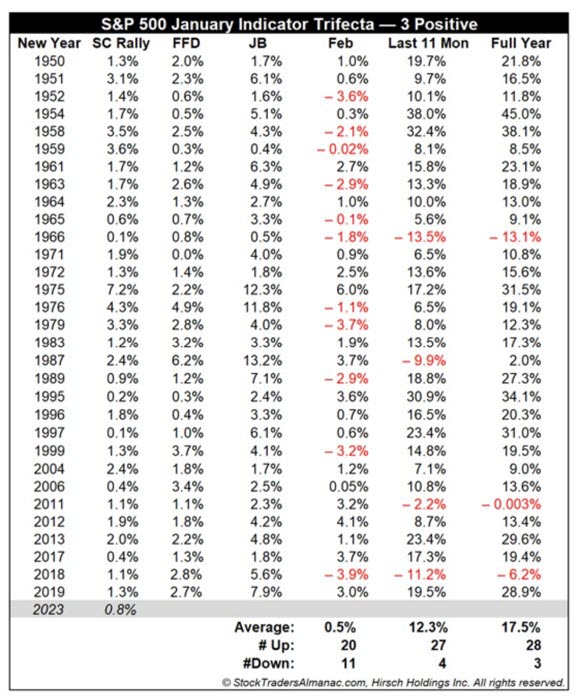
As goes January, so does the year. Since 1950 with only 7 exceptions over 72 years, when January’s performance (S&P 500) has been positive, the whole year has been positive.
As you can see from the chart below from Ryan Detrick at Carson Research, January is the best-performing month, and even more so in Pre-Election years.
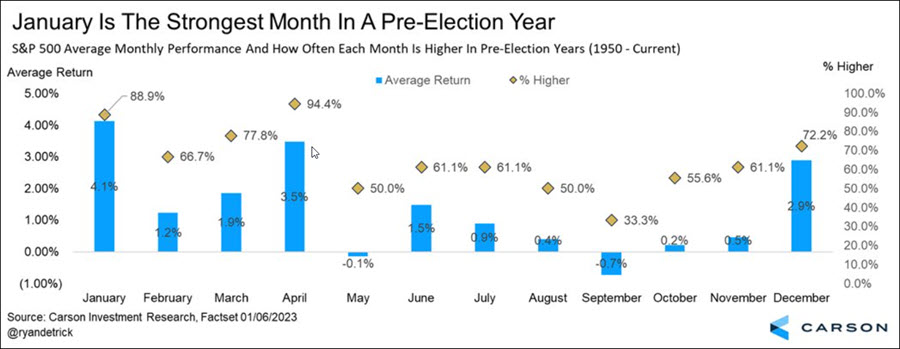
We Are in a “Risk-On” Positive Environment
This could last a while longer, or the markets could suddenly stop in their upward tracks just like they did 4 times during 2022. So far, the Nasdaq is on a 4-month high and looks to have the most momentum of all the major indices.
Don’t forget that the Nasdaq 100 index (QQQ) was down 33.0% for 2022. So a fast rebound is not surprising.
Remember, if you are down 33%, you have to gain 50% just to get back to even. Right now, the Nasdaq has made less than a quarter of the return required to recover its 2022 losses.
However, currently, the index is experiencing a much-welcomed positive bias. See the chart below:
When January has been up more than 5% following a down year, the investing climate ahead has been promising. See the chart below:
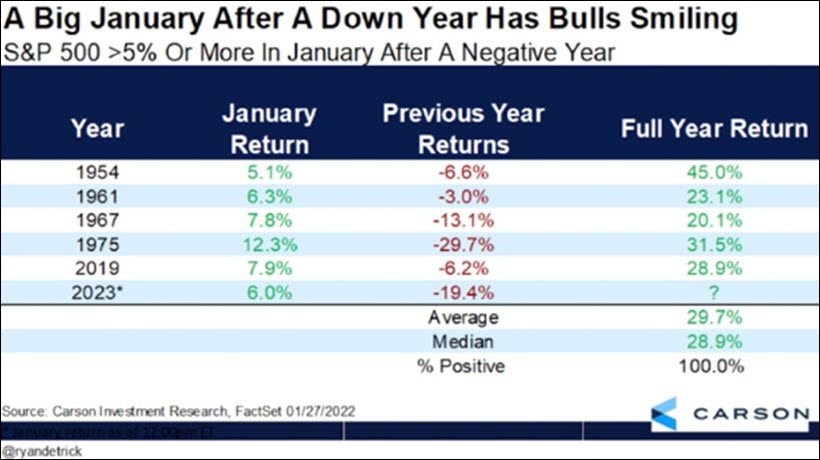
Investors Are Playing “Catch-Up”
There’s an interesting investor mentality that we have witnessed many times in the past.
In the last few months of a big correction or bear market, fear, disgust, and other understandable emotions cause investors to run to the safety of cash and “pull the plug” on some or all of their investments.
Then, as they sit on the sidelines, the market behaves more rationally and moves higher. Nothing improves market sentiment faster than a bullish trend.
As a result, those same bearish investors begin to “reload” and move back into the markets.
We see signs of more bullish investor behavior in the repeated pattern of the market opening lower on negative news, but then by the close, the market is up on the day.
Investors (including large institutions that are aggressively rebalancing) are beginning to put money to work again.
Ironically, after a big sell-off, investors often think there is way too much risk inherent in the markets when in fact, the opposite may be true:
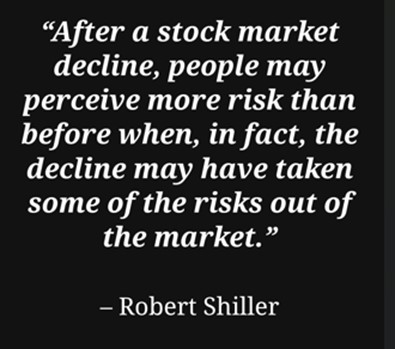
The Nasdaq, which was down more than any other market last year, has recently experienced more positive price action.
This suggests that speculators are coming back. Historically these kinds of patterns point to better future investment performance, as evidenced in the following chart:
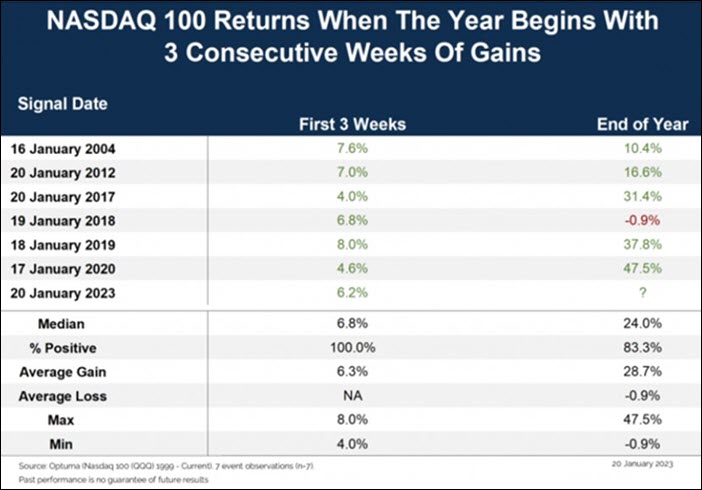
The big mega-cap stocks are the largest contributors to Nasdaq’s price changes. Several of these were down big in 2022. Investors believed that these multi-national, dominant leaders could withstand a bad market. Such was not the case.
Investors bet that earnings and profitability would hold up. So far in this earnings season, several of these companies have cited lower earnings expectations going forward.
Yet the market’s recent positive bias has favored many of these companies the most. Like a slingshot, more of the money has gone into these top components:
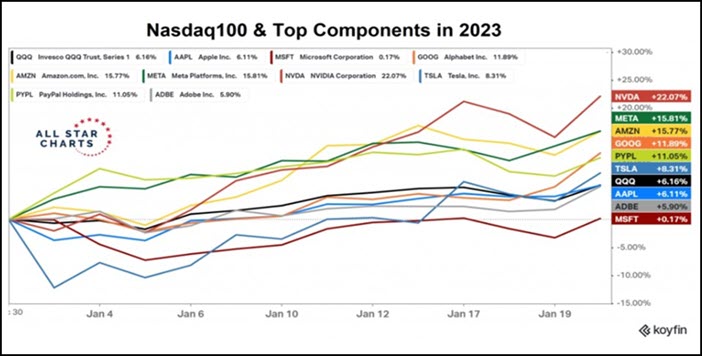
Will This Bullish Sentiment Continue?
Again, we do not know. However, given the following few facts, we would still advise exercising caution and having a plan that considers the market’s downside risk.
Here are some important facts to remember as we head into February.
- Pushing Up Into Resistance
Nasdaq (QQQ), S&P (SPDR® S&P 500 (NYSE:SPY)), and Russell 2000 (iShares Russell 2000 ETF (NYSE:IWM)) are all pushing up into or through important long-term trendlines. We suspect there will be plenty of resistance at these levels.
We’ll be looking for more confirmation to support a significant move higher and on the lookout for any weakness, given these are levels that the markets have retreated from in the recent past.
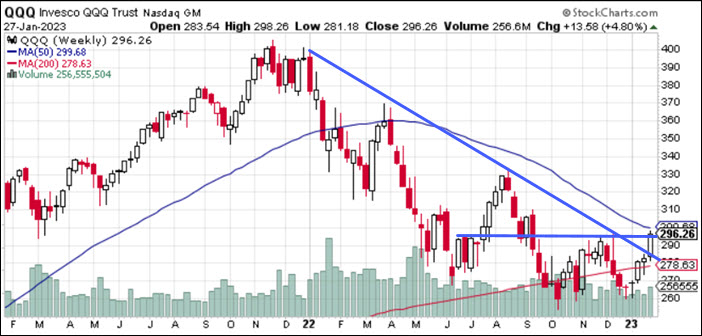
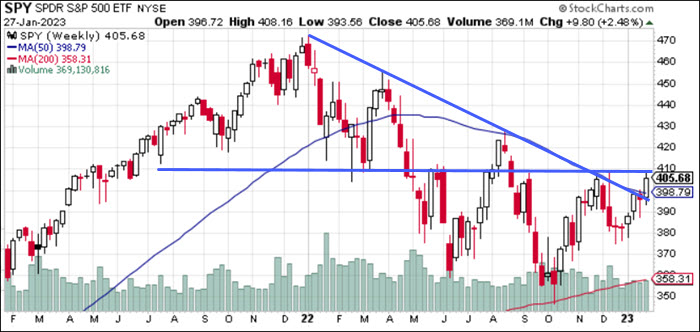

- We are in the Earnings Season
Earnings time is always full of surprises. And it is not necessarily the pure numbers or whether the company has beaten earnings expectations that drive its stock’s price action after the announcement.
Often it is the conference call that comes right after reporting the numbers that give analysts the true story. How often have we seen a company’s earnings surpass expectations, the stock rally after hours, and then the conference call create a swift and downward reversal?
As we have reported in this column numerous times, earnings are affected by increasing labor costs, raw materials, interest rates, and other input costs.
Right now, investors are seeing these factors affect earnings and stock prices.
While many companies are benefiting from rising consumer prices which contributes to higher revenues, companies’ profits are being adjusted downward.
This is going to have a dramatic effect on stock prices eventually. This is why we have said that the S&P could trade as low as 3200 or as high as 4400. See the S&P Profit forecast from FactSet below:
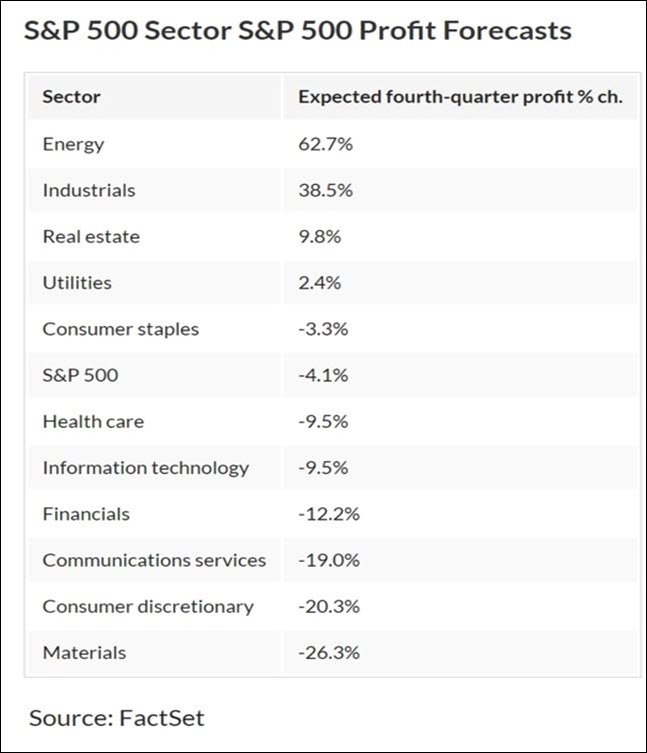
- The Fed Is Meeting Next Week
The US economy is cooling, as the Federal Reserve would like. Unfortunately, the growth of the economy has not stalled. Yesterday the 4th quarter GDP came out above expectations at 2.9%.
Additionally, this past week the Fed’s preferred inflation measure, the PCE (Personal Consumption Expenditure) number came out at its lowest pace in more than a year (temporary workers declined due to seasonal factors).
This will likely make the Fed downshift the size of its interest rates as expected when it meets this week.
Our view is if the Fed backs off its monetary tightening too soon, inflation could climb again.
Here are several reasons why we believe the Fed should continue being aggressive (and not pivot to a dovish stance):
-
- Inflation is still too high. Our experience is it could take several years to bring down to the Fed’s target.
- The labor force is still too tight. There are immense worker shortages which will continue to put pressure on labor costs.
- Rents in the US are still very high and putting pressure on inflation, especially in big cities like Phoenix, Denver, Miami, Dallas, etc. The inflation rate in many of these cities is closer to 7-9% and not the 4-4.5% the media keeps reporting.
Everyone is looking for and hoping for a soft landing. It’s not likely to happen. The American economy does not go through a monetary tightening cycle like the one we are in and lands softly.
Which is the next reason we believe you should be cautious about your investments right now:
- Many Americans Are Bracing for a Recession
A recent Morning Consult Survey found that 46% of Americans believe we are already in a recession. Another 25% are bracing for the start of one. Amanda Snyder, a finance reporter at Morning Consult, said,
“We’re not officially in a recession. But if people feel that their money is not going as far as it was or their income is shrinking, then they personally are experiencing a financial downturn,”
This is the true meaning of stagflation, and we believe it keeps pressure on the US economy, the company’s sales, and profits, and it may eventually find its way into the stock market’s performance.
- February’s Historically Weak Performance Improves in Pre-election Years
The S&P 500’s performance in February since 1950 has been positive 56% of the time, but it has had a negative average return of -.14%.
However, our friends at Stock Trader Almanac point out in the table below that February in Pre-Election years have a much higher win rate and a modest positive average return.
After the big run-up we saw in January, we suspect the market will pause or digest some of the gains. See the chart below:
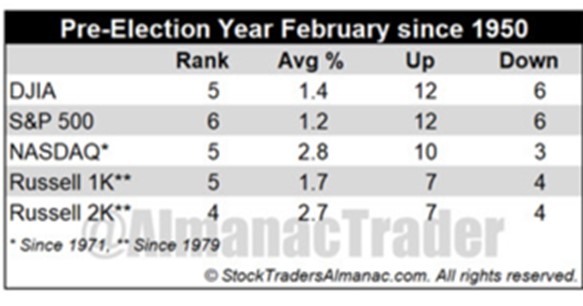
Here are our technical observations:
Risk-On
- The Trend Strength Indicator (TSI) improved across all 4 key indices, with Small Caps (IWM) and the Dow (DIA) leading the bunch and closing on Friday above on their long-term moving averages. (+)
- Although later than the other indices, the Nasdaq 100 (QQQ) regained its 200-day moving average on Friday for the first time in roughly 10 months. (+)
- Risk-On sectors, including Semiconductors (SMH), Retail (XRT), and Consumer Discretionary (XLY) took off this week, while Risk-Off sectors like Utilities (XLU) were down. (+)
- This week’s laggards were energy stocks, with US Oil (USO (NYSE:USO)) and US Natural Gas (UNG) down on the week, with USO likely digesting some of its gains from the past 6 months. (+)
- Risk Gauges have improved to Risk-On across the board after printing at neutral levels last week. (+)
- Cash Volatility ($VIX.X) continues to set new lows. (+)
- The number of stocks above key moving averages has improved across the board for both the S&P500 and the Russell 2000 indices. (+)
- Growth stocks (VUG) continue to drastically outperform Value stocks (VTV) on a short-term basis. (+)
- Nearly every member of Mish’s Modern Family continues to improve, with IWM, IYT, and SMH all putting in Golden Crosses on their charts and XRT not far behind as it looks to improve into its own bullish phase next week. (+)
- Foreign Equities (EEM & EFA) continue their outperformance over US equities. (+)
Neutral
- Despite the strong move across the indices this week, volume patterns are slightly weaker compared to last week. (=)
- The McClellan Oscillator failed to confirm new highs this week for both the S&P500 and the Nasdaq Composite, a daunting sign as the indices look to confirm a break of their long-term downtrends. (=)
- The 52-week New High / New Low ratio for the S&P 500 has plateaued at its highest level since 2021. (=)
- The Volatility Ratio (VIX/VXV) has failed to improve and looks to be forming a tightening wedge, indicating a high likelihood for a breakout in volatility in the week to come. (=)
- Treasury Bonds are in a neutral zone between their 50 and 200-day moving averages as they await the results of next week’s FOMC. (=)
- Gold (GLD (NYSE:GLD)) held firm as it is currently digesting overbought conditions, but it has given up its short-term leadership over the S&P 500. (=)
- Oil (USO) failed to follow through on its reclaim of the 50-day moving average and is currently stuck in a weak recovery phase. (=)
Risk-Off
- The 52-week New High / New Low ratio for the Nasdaq Composite has actually begun to deteriorate, a clear Risk-Off indication for the short term. (-)
- Despite the improvement in the market, the Yield Curve has actually continued to invert further. (-)
- Soft Commodities (DBA) bounced off of a critical support area and regained its recovery phase this week by closing back above its 50-day moving average. (-)
